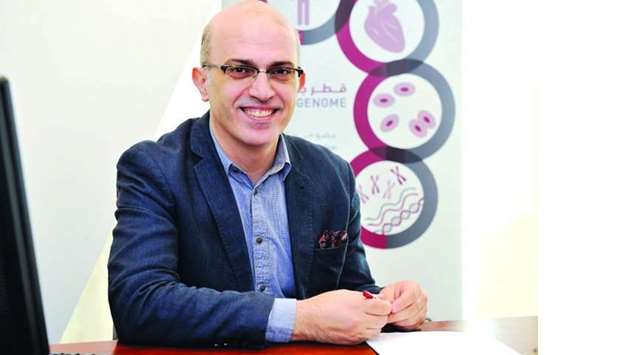A majority of the over 400mn-strong Arab population is largely unaccounted for in global genomic studies, according to Dr Said Ismail, director of Qatar Foundation’s Qatar Genome Programme (QGP).
“Diversity in genomics is a real problem. Between 75-80% of the genetic information in the global genomics databases is of people of European descent, followed by 10% Asian, 2% African, 1% Hispanic, and less than 1% for all other groups,” Dr Ismail said.
The human genome is akin to a puzzle, every ethnicity represents a part of the puzzle. At present, some parts of the puzzle are very well defined such as Europeans. Other parts are present but still missing some pieces such as Africans and Asians. Yet another part of the puzzle is almost absent – it is just one large gaping hole – and this part represents Arabs.
“For any ethnicity to benefit from precision medicine, the first step is to sequence and understand its genomes. This is exactly what QGP has been focusing on during the past five years. We have sequenced around 20,000 Qatari genomes and are in the process of sequencing 3,000 of the country’s non-Qatari Arab residents to create the first comprehensive Arab reference genome,” Dr Ismail said.
“To figure out any anomalies in the base pairs, we need a standard that we can compare it to – this is what is called a reference genome. It is a template genome incorporating the most up-to-date information we have on human genomics, created by putting together a large number of genomes,” he said.
"Comparing a sequenced genome to a reference genome allows us to identify the similarities and differences between the two. Here is where the problem is, the current reference human genome is very much lacking mutations specific to the Arab population. What this means is, if an Arab person’s genome is compared to a European reference human genome, there is a possibility they will either be misdiagnosed or undiagnosed."
The same disease can manifest through different mutations in different ethnicities, according to Dr Ismail. “Examples include hereditary disorders like thalassemia, cystic fibrosis and also familial cancers like breast and colon cancer, where you’ll find that different populations may have different causative mutations along the relevant genes.
“So far, we have sequenced 20,000 Qatari genomes, and within the next few months we hope to have sequenced 10% of the Qatari population. While the end-goal is to sequence the vast majority of the population, scientifically, 10% is good enough to capture most of the medically relevant gene variants.
“This has also allowed us to establish the first comprehensive Qatari reference genome. We now know what the main components of the Qatari reference genome are. In this process, we have identified markers that have never been reported before and are unique to the Qatari population,” he said.
“The next step is to shift gears from research to clinical implementation, and we hope to initiate this in collaboration with Hamad Medical Corporation, Sidra Medicine and other health care providers in the very near future.”
The human genome is akin to a puzzle, every ethnicity represents a part of the puzzle. At present, some parts of the puzzle are very well defined such as Europeans. Other parts are present but still missing some pieces such as Africans and Asians. Yet another part of the puzzle is almost absent – it is just one large gaping hole – and this part represents Arabs.
“For any ethnicity to benefit from precision medicine, the first step is to sequence and understand its genomes. This is exactly what QGP has been focusing on during the past five years. We have sequenced around 20,000 Qatari genomes and are in the process of sequencing 3,000 of the country’s non-Qatari Arab residents to create the first comprehensive Arab reference genome,” Dr Ismail said.
“To figure out any anomalies in the base pairs, we need a standard that we can compare it to – this is what is called a reference genome. It is a template genome incorporating the most up-to-date information we have on human genomics, created by putting together a large number of genomes,” he said.
"Comparing a sequenced genome to a reference genome allows us to identify the similarities and differences between the two. Here is where the problem is, the current reference human genome is very much lacking mutations specific to the Arab population. What this means is, if an Arab person’s genome is compared to a European reference human genome, there is a possibility they will either be misdiagnosed or undiagnosed."
The same disease can manifest through different mutations in different ethnicities, according to Dr Ismail. “Examples include hereditary disorders like thalassemia, cystic fibrosis and also familial cancers like breast and colon cancer, where you’ll find that different populations may have different causative mutations along the relevant genes.
“So far, we have sequenced 20,000 Qatari genomes, and within the next few months we hope to have sequenced 10% of the Qatari population. While the end-goal is to sequence the vast majority of the population, scientifically, 10% is good enough to capture most of the medically relevant gene variants.
“This has also allowed us to establish the first comprehensive Qatari reference genome. We now know what the main components of the Qatari reference genome are. In this process, we have identified markers that have never been reported before and are unique to the Qatari population,” he said.
“The next step is to shift gears from research to clinical implementation, and we hope to initiate this in collaboration with Hamad Medical Corporation, Sidra Medicine and other health care providers in the very near future.”



